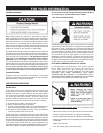
18
11.Close the water heater drain valve by turning the handle to the
right (clockwise). The drain valve is on the lower front of the
water heater.
12.Open the cold water supply valve to the water heater.
NOTE: The cold water supply valve must be left open when
the water heater is in use.
13.To insure complete filling of the tank, allow air to exit by opening
the nearest hot water faucet. Allow water to run until a constant
flow is obtained. This will let air out of the water heater and the piping.
Never use this water heater unless it is completely full of water. To
prevent damage to the tank and heating element, the tank must be
filled with water. Water must flow from the hot water faucet before
turning “ON” power. The manufacturer will not warrant any elements
damaged by failure to follow instructions.
14.Check element for water leaks. If leakage occurs, tighten element
or repeat Steps 2 and 3, remove element and reposition gasket.
Then repeat Steps 10 through 14.
15.Reconnect the two wires to the element and then check to make
sure the thermostat remains firmly against the surface of the tank.
FIGURE 20.
16.Replace terminal cover on thermostat making sure the locking
tabs on the terminal cover are in place.
17.Replace the insulation so that it covers the thermostat and
element, see Figure 21.
18.Replace outer door.
19.Turn “ON” electric power to water heater.
FIGURE 21.
DRAIN VALVE WASHER REPLACEMENT
(See Figure 22)
1. Follow “Draining” instructions.
2. Turning counter clockwise (
), remove the hex cap below the
screw handle.
3. Remove the washer and put the new one in place.
4. Screw the handle and cap assembly back into the drain valve
and retighten using a wrench. DO NOT OVER TIGHTEN.
5. Follow instructions in the “Filling The Water Heater” section.
6. Check for leaks.
FIGURE 22.
SERVICE
If a condition persists or you are uncertain about the operation of
the water heater contact a service agency.
Use this guide to check a “Leaking” water heater. Many suspected
“Leakers” are not leaking tanks. Often the source of the water can
be found and corrected.
If you are not thoroughly familiar with your water heater and safety
practices, contact a qualified installer to check the water heater.


















